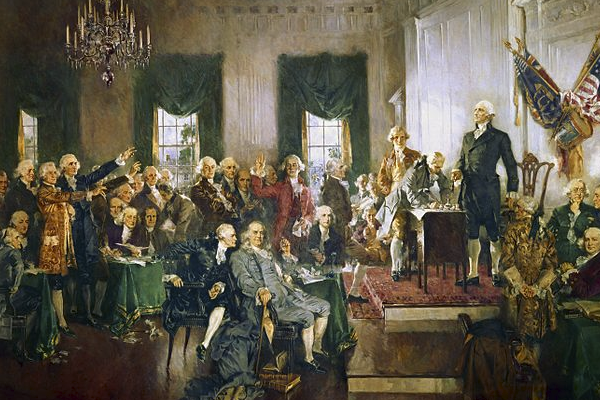How the Constitution Can Accommodate Divergent Values

The Declaration of Independence charged that King George III and parliament had “…subject[ed] us to [British laws] foreign to our constitution…” Yet in 1776 (when the Declaration was written) there was no written American constitution. Why did Jefferson write “our constitution”?
Jefferson was asserting that across the 13 British-American colonies there was a shared belief about how America should be governed.
Eleven years after the Declaration, the Constitutional Convention devised a system of federal and national government, which it set out in the Constitution. That system built on the shared constitutional beliefs and experience of Americans but also allowed for the diversity of other American beliefs and values.
The moral issue which most divided revolutionary America was not abortion: it was the institution of slavery. By the time of the Constitutional Convention in 1787, Massachusetts had abolished slavery through its new Bill of Rights, and other New England States were moving towards abolition. Georgia and South Carolina were adamant that they would not join the Union if slavery or the slave trade were suppressed. Some Virginian slave owners at the Convention spoke against slavery, on moral grounds.
The original Constitution addressed slavery in three places: once when dealing with the allocation of votes and taxes; once when prohibiting a ban on the importation of slaves before 1808; and once when requiring all States to return slaves who had escaped from other States.
By 1776, the British-American political system included: a legislature in each colony, with a chamber elected by most white men who owned property; jury trials, and the application of the common law; low taxes; the limited exercise of British power in the colonies; and a belief that the colonies should be able to grow westward.
The Declaration was electrifying in its assertion of “certain unalienable rights; …among these are life, liberty, and the pursuit of happiness”. How did the Constitution give effect to these rights?
Not by setting out personal rights. The original Constitution was focused on establishing the machinery of a new system of republican federal and national government. It was this system, rather than the express enumeration of individual rights, which would protect Americans’ liberty and protect them from tyranny.
Both at the Constitutional Convention and during the ratification debates many Americans wanted to follow the practice, which began with the English Bill of Rights of 1689 and was picked up in many of the State Constitutions, of setting out certain individual rights as paramount rights which American governments and law would have to respect. The American Bill of Rights was added to the Constitution almost immediately after ratification.
When founding the nation, American political leaders had to both leverage Americans’ shared political culture and beliefs, and allow for Americans’ differing moral beliefs and values.
In some ways, differing beliefs about the issue of abortion are even more politically difficult than about slavery. Defenders of slavery claimed that it was economically, not morally, necessary. Anti-slavery advocates believed that there was a moral imperative to abolish slavery.
With abortion, pro-lifers believe that abortion is immoral in many circumstances, while pro-choicers believe that it is immoral to prohibit abortion in many circumstances. The difference in perception of the moral issues intensifies the political division.
The possibility of the Supreme Court being activist in constitutional issues would have surprised the founding generation, who knew that differences in values across the 13 original States were a political reality, with slavery being the most obvious example.
Since the Second World War, internationally human rights treaties and constitutional protections have expanded immensely in scope. Some Americans see a role for the Supreme Court in responding to the changed human rights environment by finding rights which were not explicit in the Constitution or the Bill of Rights. For originalists, the express enumeration of rights is a constraint on the Court’s ability to do this.
The question now is the extent to which differences should be resolved through State democratic processes or constrained by the Supreme Court finding individual rights as paramount rights.
The challenge of enabling a single federal/national government in a nation with differing (as well as many shared) convictions about moral issues has been with the nation since its founding.